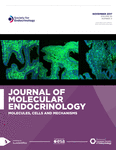Molecular pathology and genetics of pancreatic endocrine tumours
- Gabriele Capurso,
- Stefano Festa,
- Roberto Valente,
- Matteo Piciucchi,
- Francesco Panzuto,
- Robert T Jensen1 and
- Gianfranco Delle Fave
- Digestive and Liver Disease Unit, Faculty of Medicine and Psychology, S. Andrea Hospital, Sapienza University of Rome, Via di Grottarossa 1035, 00189 Rome,
Italy
1Digestive Diseases Branch, National Institute of Diabetes and Digestive and Kidney Diseases, National Institutes of Health, Bethesda, Maryland, USA
- (Correspondence should be addressed to G Delle Fave; Email: gianfranco.dellefave{at}uniroma1.it)
Abstract
Pancreatic neuroendocrine tumours (PETs) are the second most frequent pancreatic neoplasms. Their poor chemosensitivity, high rate of metastatic disease and relatively long survival make PETs an ideal field to be explored for novel therapies based on specific molecular changes. PETs are generally sporadic but can also arise within hereditary syndromes, such as multiple endocrine neoplasia type 1, von Hippel–Lindau, neurofibromatosis type 1 and tuberous sclerosis complex, which represent a model for sporadic cases too. Among allelic imbalances, main genomic changes involve gain of 17q, 7q and 20q and loss of 11q, 6q and 11p, which identify regions of putative candidate oncogenes or tumour suppressor genes (TSGs), respectively, sometime with potential prognostic significance. Overexpression of Src-like kinases and cyclin D1 (CCND1) oncogene has been described. As for TSGs, P53 (TP53), DPC4/SMAD4 and RB (RB1) are not implicated in PET tumorigenesis, while for p16INK4a (CDKN2A), TIMP3, RASSF1A and hMLH1, more data are available, suggesting a role for methylation as a silencing mechanism. In the last decade, gene expression profile studies, analysis of microRNAs and, more recently, large-scale mutational analysis have highlighted commonly altered molecular pathways in the pathology of PETs. The roles of the mammalian target of rapamycin pathway, and its connection with Src kinases, and the activity of a number of tyrosine kinase receptors seem to be pivotal, as confirmed by the results of recent clinical trials with targeted agents. Mutations of DAXX and ATRX are common and related to altered telomeres but not to prognosis.
- Revision received 3 May 2012
- Accepted 14 May 2012
- Made available online as an Accepted Preprint 14 May 2012
- © 2012 Society for Endocrinology











